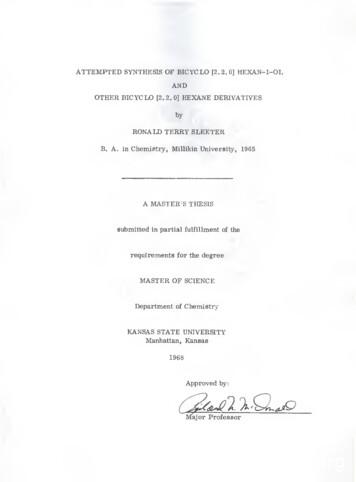CIS 8040 Fundamentals Of Database Management Systems .
CIS 8040 – Fundamentals of Database Management SystemsCourse SyllabusBuckhead Center, Room 627Wednesdays 5:30-9:45 PMInstructor:Dr. Wael JabrEmail: wjabr@gsu.eduPhone: 404.413.7363Office hours: By appointmentPrerequisites:CIS 3210 or CIS 3260.Textbook & Supplementary material:Fundamentals of Relational Database Management Systems, By S. Sumathi and S. Esakkirajan, SpringerVerlang, 2010, ISBN 978-3-642-08012-8; eISBN 978-3-540-48399-1. (referred to below as S&E)A good supplementary resource: 5-links.htmSuggestions for (optional) reading material from students are also appreciated (please email them to me).Course Catalog Description:Developing and managing efficient and effective database applications requires understanding thefundamentals of database management systems, techniques for the design of databases, and principles ofdatabase administration. This course emphasized database concepts, developments, use and managementin three main sections: database concepts, practice, and emerging trends. Relational database systems arethe main focus, but other types, including object- oriented databases, are studied. Practical design of databases and developing database applications using modern software tools will be emphasized.Detailed Course Description:Upon successfully completing this course, the student will:1) Understand the fundamentals of relational, object-oriented, and distributed database systemsincluding: data models, database architectures, and database manipulations2) Understand the theories and techniques in developing database applications and be able todemonstrate the ability to build databases using enterprise DBMS products such as Oracle or SQLServer.3) Be familiar with managing database systems4) Understand new developments and trends in databases.
Course Project:The project consists of a research report and presentation on a topic of your choice that is relevant to thecourse. It is group-based. Check the course site for details.Course Software:Oracle SQL Developer will be used for hands-on activities. It is an integrated environment for thedevelopment and management of Oracle Database and is available to you for free. Check the course sitefor download instructions.Typical class session:Class sessions will comprise (1) lecture/discussion of certain database software concepts and features, (2)instructor demonstrations of these same database software concepts and features, and (3) student labsessions working with these same database software concepts and features.The purpose of this pedagogical approach is to introduce and reinforce ideas and skill sets so that studentscan master these on their own after class hours. To bring this knowledge to a highly proficient,professional level, students will have to spend time and effort outside of class using the system.To ensure that you have the basic knowledge that will allow you to function on your own after class, besure to ask the instructor questions during class, either during the lecture/discussion, demo, or lab.Classroom guidelines:Attendance is not mandatory but highly recommended.Coming to class fully prepared helps push the conversation much further.Make-up exams are not available (except for excused absences).Individual deliverables are to be submitted individually and group work is collaborative.Grading:DeliverablesLab Assignments25%Project20%Midterm25%Final exam25%Participation5%100%Total*Late submission policy: deliverables submitted after their due date will be penalized 10% per day.No submission is accepted after the fifth day.Letter Grade Scale9894908682797571686562A AA-B BB-C CC-D DLessthan61FAdditional information: Refer to http://www2.gsu.edu/ wwwfhb/sec400.html for additional guidance oninstructional information.
Schedule of Classes (also check the “schedule of readings & questions” in the next table)WeekTopic1Introduction to databasemanagement systems Basic : Ch. 1 – pp. 1-20S&E: Ch. 2 – pp. 3142; 51-53; 60Database ModelingDownloadsHierarchical Data ModelNetwork Data ModelIntro. SlidesDBMS Concepts SlidesSemantic Modeling Slide2The Relational DataModelLab 1assignedConceptual Design:Mapping RelationalModelS&E: Ch. 3 – pp. 6571ER for class exampleS&E: Ch. 3 – pp. 7289Mapping the ER Model SlidesRelational Data Model SlidesPerfect Pets Practice SpecsPerfect Pets ER Solution3SQL an introductionLab 1 dueSQL (DDL)4S&E: Ch. 4 - pp. 169191; 201Oracle SQL Developer InstallationSQL SlidesSQL (DML)SQL (Oracle specific)S&E: Ch. 5 – 213-267S&E: Ch. 6 – pp. 288311Oracle SQL / Oracle DDLOracle Char. Func.Oracle Numeric & Date FunctionsOracle Parameters, Variables, &ViewsOracle PL/SQL Intro.R.A. Example Answers from Inclass exercise5MidtermRelational Commands,Embedded SQL, StoredProcedures, TriggersLab 2assignedTopic: Databasemanagement & BigdataS&E: Ch. 7 - pp. 319334Guest Speaker6Exam Review FunctionalDependencies,NormalizationGuest Speaker7Database administration– TransactionManagement– ConcurrencyContolObjectRelational Views and the SystemCatalog SlidesLab 2 dueLab 3&4assignedFlavio Villanustre; VP Infrastructure & Security atHPCC Systems & LexisNexisNormalization SlidesKent's Five Normal Forms ArticleTopic: the evolution of Matt McGivern; Managingthinking towardsDirector, Business Intelligence &DBMSData Governance Lead at ProtivitiDatabase AdministrationS&E; Ch. 8; pp. 353370Oracle User Creation
Distributed and CloudDatabasesBig Data & NoSQL8Final ExamLab 3&4 dueOverview of Big Data andNoSQLGroupProject due*While we will follow this syllabus throughout the term, some changes might be necessary.Schedule of Readings & QuestionsSession1TopicIntroduction todatabasemanagementsystems - BasicconceptsDatabaseModelingReadingsCodd, E. F. “A Relational Model of Datafor Large Shared DataBanks.” Communications of the ACM 13,no. 6 (1970): 377-387. (Focus on sections1.3 and all of section 2.) (availablethrough library – requires username &password)1.2.3.4.1.What do we learn from the evolution of SQL? What’s theroad ahead?Exam Review1.What problems does schema normalization solve? Do youbelieve that these are important t is the distinction between BCNF and 3NF? Is there areason to prefer one over the other?3.Think about a data set you have worked with recently, andtry to derive a set of functional dependencies thatcorrespond to it. What assumptions did you have to makein modeling your data in this way?4.How is it that ER modeling generally leads to BCNF/3NFschemas?Franklin, Michael. 1997. "ConcurrencyControl and Recovery." The ComputerScience and Engineering Handbook. pp.1058-1077 (PDF)1.What is the tradeoff between coarse granularity (e.g.,table-level) and fine granularity (e.g., tuple-level) locks ina database system?What are the performance tradeoffs between the differentdegrees of locking?Chang, F. et al. "Bigtable: A DistributedStorage System for Structured Data."OSDI, 2006. (PDF).Ovide, S. Once Again, Oracle MustReinvent Itself; As Larry Ellison LeavesCEO Post, Company Faces Major ShiftsReshaping Its Market. Wall Street JournalSept. 19, 2014 (available through library).1.3SQL anintroduction678DatabaseadministrationBig Data &NoSQLJim Melton, 2006, “Database LanguageSQL”, pp 105-132, In Handbook onArchitectures of Information Systems,Ed. P. Bernus, K. Mertins, G. Schmidt(book freely available online)QuestionsWhat is the notion of data independence? Why is itimportant?Codd spends a fair amount of time talking about "Normalforms". Why is it important that a database be stored in anormal form?What are the key ideas behind the relational model? Whyare they an improvement over what came before? In whatways is the relational model restrictive?What, according to Codd, are the most importantdifferences between the "hierarchical" model (asexemplified by systems like IMS) and the relationalmodel that Codd proposes? Make sure you understandwhat Codd means by "Data Dependencies".2.2.3.4.In what ways does Bigtable replicate the behavior of arelational database? How is it different?Could Google have built Bigtable using a relationalsystem? Would that have been a good idea? Why so?What consistency guarantees does Bigtable provide in theface of failures?What is a distributed lock service?
AppendixMSA Program Goals and ObjectivesGoals:Students completing the MS in Analytics will:G1Understand organizational problems in general and associated analytical problems in particular.G2Proficient in the management of data needed for decision-making.G3Proficient with the methodological skills needed for data-driven decision-making.G4Understand the implementation issues that accompany analytical problem solving.G5Be able to demonstrate the positive impact on analytics on organizations.Objectives/Learning Outcomes (LO):After finishing the program students are expected to have mastered the knowledge and skills to carry outthe following analytical tasks:LO1LO2Frame Business Problems (G1) MSA students will properly frame a business problem.Frame Analytical Problems (G1) MSA students will demonstrate the ability to properly solveanalytical problems.LO3Data Management (G2) MSA students will effectively acquire, clean, and manage both structuredand unstructured data.LO4Methodology (G3) MSA students will identify and apply the appropriate methodology for thebusiness and analytical problem(s) identified.LO5Modeling (G3, G4). MSA students will build and deploy analytical models across organizationsthat fit the underlying organizational needs and the analytical problem(s) identified.LO6Programming (G4). MSA students will solve analytical problems by utilizing computerprogramming, both by employing available tools where possible and by developing customizedsolutions where necessary.LO7Life Cycle Management. (G3, G4). MSA student(s) will develop adaptable models that allow forcontinued organizational improvement of productivity and qualityLO8Organizational Impact (G5) MSA student(s) will effectively communicate the positive, strategicimpact of a model on the firm to which it is being applied.
Oracle SQL / Oracle DDL Oracle Char. Func. Oracle Numeric & Date Functions Oracle Parameters, Variables, & Views Oracle PL/SQL Intro. R.A. Example Answers from In-class exercise 5 Midterm assigned Relational Commands, Embedded SQL, Stored Procedures, Triggers Guest Speaker Lab 2 Topic: Database management & Big data Relational Views and the System
CIS 175 Java II CMSC 150 CIS 178 Java Programming I CIS 260JA CIS 179 Java Programming II CIS 260JA or CIS # CIS 189 Python MIS 150 CIS 303 Intro to Data Base CIS # CIS 332 Data Base and SQL CIS 255 CIS 338 SQL/Oracle CIS # CIS 346 Data Base Design CIS # CIS 402 COBOL CIS # CIS 451 PLTW - Comp Sci Applications CIS #
cis-Cyclobutane-1,2-dicarboxylicAnhydride 62 cis-l,2-Bis(hydroxymethyl)cyclobutane 62 cis-l,2-Bis(bromomethyl)cyclobutane 62 cis-l,2-Bis(cyanomethyl)cyclobutane 62 cis-l,2-CyclobutanediaceticAcid 62 DimethylCyclobutane-cis-1,2-di-cC-bromoacetate 62 cetate withSodiumHydride 62
CIS Microsoft Windows 7 Benchmark v3.1.0 Y Y CIS Microsoft Windows 8 Benchmark v1.0.0 Y Y CIS Microsoft Windows 8.1 Benchmark v2.3.0 Y Y CIS Microsoft Windows 10 Enterprise Release 1703 Benchmark v1.3.0 Y Y CIS Microsoft Windows 10 Enterprise Release 1709 Benchmark v1.4.0 Y Y CIS .
the CIS’s suitability to be a Qualifying CIS; or 5. winding up of an Qualifying CIS; and (l) in addition to the requirements in (a) – (k) above, the CIS Operator must be subject to the requirements in its Home Jurisdiction. 1.10 A CIS Operator which participates in this Framework is de
Peter-Michael Osera posera@cis.upenn.edu Richard Eisenberg eir@cis.upenn.edu Christian DeLozier delozier@cis.upenn.edu Santosh Nagarakatte santoshn@cis.upenn.edu Milo M. K. Martin milom@cis.upenn.edu Steve Zdancewic stevez@cis.upenn.edu August 5, 2013 Core Ironclad is a c
CIS SELFSTUDY LESSON LAN Lesson No. CIS 279 (Instrument Continuing Education - ICE) BY SUSAN KLACIK, BS, CRCST, CIS, CHL, ACE, FCS, IAHCSMM CLINICAL EDUCATOR Environmental Responsibility: Keeping Sterile Processing Departments Clean and Functional Certified Instrument Specialist (CIS) lessons provide members with ongoing education in
General E-mail address: cis@cis.usouthal.edu School Web Site: www.cis.usouthal.edu Dean Dr. David Feinstein 460-6390 FCW 20 dfeinstein@usouthal.edu Coordinator of Computer Science Dr. Michael Doran 460-6390 FCW 14 mdoran@usouthal.edu Coordinator of Information Systems & Director of CIS Graduate Studies Dr. Roy Daigle 460-6390 FCW 10 rdaigle .
Configuration Assessment Tool (CIS-CAT) A cornerstone of CIS Security Benchmarks resources is CIS-CAT, our . Configuration Assessment Tool . CIS-CAT is a powerful resource for analyzing . tests to CIS-CAT's capabilities, for a total of 120, thus increasing the technologies it covers from 53 Benchmarks at the beginning of the year to























